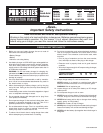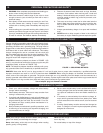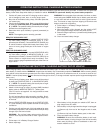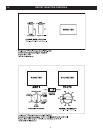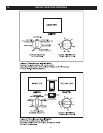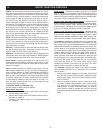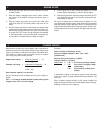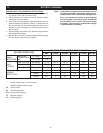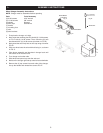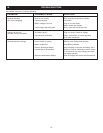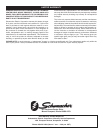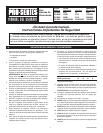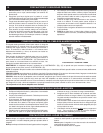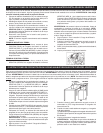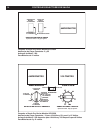
6
H. OUTPUT SELECTOR CONTROLS
TIMER: The main function of the timer is to prevent over charg-
ing while allowing a battery time to obtain a satisfactory charge.
To properly set the timer you must know the size of the battery
in ampere hours or reserve capacity in minutes and the state of
charge. Often the state of charge is not known, this is one rea-
son why the timer was limited to 2.25 hours. With the aid of a
battery load tester the state of charge can be obtained within a
few seconds. For example, the average size automotive battery
at a 50% state of charge will require 1 to 1.5 hours of charging
at the 40 amp rate to reach the full charge state. For the same
battery with the timer set to it’s maximum, 2.25 hours, over charg-
ing will occur, but not likely cause harm to a battery that was
other wise in good condition. When the charge state is not known,
start out with a timer setting of 1 hour or less.
HOLD: This position defeats the timer function, allowing for con-
tinuous operation. Use when you want to charge more than 2.25
hours. This is normally the case when the 2 amp charge rate is
selected. Be sure to monitor the charging and stop the charge
when the battery is charged.
Switch #1 - Use this switch to select the 200 Amp Engine Start
and the 35 Amp Charge Rate. Switch #2 must be in the down
position (Select Position) when using Switch #1.
Switch #2 - Use this switch to select the 2 Amp Charge Rate and
OFF position. Also, use to select use of switch #1. Note that switch
#1 is only effective when switch #2 is set to “Select Position”.
Rotary switch - Use the rotary switch (volt / rate selector, on all
models except the PS-2352) to select the charge rate or engine
start setting you require. Read the switch dial for those avail-
able on this charger.
Model PS-3000 employs a 7-position rotary switch. You may
select output voltages of 6, 12, 18 or 24 volts for charging bat-
teries of those voltages or battery combinations connected in
series (not parallel) in which the sum of the battery voltages
adds up to the range selected. Each voltage range offers a high
or low amp charge rate. The higher charge rate is more suitable
for fast charging a battery to the point where it will start a ve-
hicle, the lower (slower) charge rate is more suitable for fully
charging (restoring) a battery.
Load Tester Switch (on PS-8050 only)
Use this switch to apply load to the battery.
Follow these easy steps:
1. Select the correct setting of the meter ( 6V or 12V ) to agree
with the battery to be tested.
2. Connect the charger leads to the battery following the in-
structions in section F.
3. Press the Load Switch to load on for 10 seconds and read
the voltmeter.
Good (green) - indicates the battery capacity is OK. Battery
may or may not be fully charged. Check the specific gravity of
battery to determine the state of charge. If the specific gravity is
less than full charge, check for electrical drain or possible charg-
ing system trouble. Recharge battery to full level.
Yellow or Red, but needle remains steady - indicates that the
battery capacity is not satisfactory. Battery may be either defec-
tive or not fully charged. Check specific gravity to see which
condition exists. It charging does not bring the battery specific
gravity to full charge, the battery should be replaced.
Yellow or Red, but needle remains falling - indicates the bat-
tery may be defective or run down. Release the load switch and
note voltmeter reaction. Voltage recovery into green or above
within seconds indicates a defective battery. Slow recovery indi-
cates run down condition. For best results, check specific gravity.
The Ammeter indicates the amount of current measured in am-
peres that is being drawn by the battery. For example, In the 50
amp charge rate a typical discharged battery will initially draw
approximately 50 amps. As the battery continues to charge, cur-
rent will taper to 15 to 20 amps at full charge. The Start area of
the meter indicates a high rate of current being drawn from the
charger. When cranking an engine, the starter motor draws up-
wards to 200-300 amps. The meter needle will be at the ex-
treme right side of the start area. Sometimes a battery for the
first few minutes of it’s charge will draw more than 40/60 amps,
in this case the needle may be within but not to the extreme
right side of the start area. The 2 amp charge rate (on some
models) may indicate some activity on the meter. The meter
doesn’t have the resolution to display this low rate.
The Voltmeter indicates the voltage at the battery terminals.
Note that Model PS-5250 is not a load tester, but a voltmeter.
Use as follows:
1. Charger need not be plugged into AC outlet. Timer should
be in the OFF position, 6V/12V switch in position to match
battery being tested, and then connect following instruc-
tions in Section F.
2. Observe the meter indication. Keep in mind that this read-
ing is only a battery voltage reading, a false surface charge
may mislead you. We suggest that you turn on your
headlamps for a couple of minutes before you read the
meter. Read a couple of minutes after you have shut the
headlamps off, then follow the convenient color code of the
meter.



